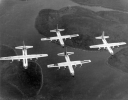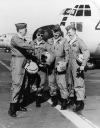
The "Four Horsemen" were an US Air Force aerobatic display team that flew four C-130A Hercules transpor aircraft.
The team's history began in early 1957, when four C-130A Hercules air-crews decided to try formation flying, after their air dropping mission had been canceled during heavy winds at Fort Campbell, Kentucky. The pilots of these Hercules were Captains Gene Chaney, Jim Aiken, David Moore and Bill Hatfield.
The team was first named the "Thunder Weasels" drawn from a combination of the "Thunderbirds" name and the weasel from the squadron patch, but later the pilots chose the new name "Four Horsemen" regarding to Four Horsemen of the Apocalypse.
The team's first public demonstration was in front of 314th Troop Carrier Wing at Sewart Air Force Base in Tennessee, when the "Four Horsemen" pilots were delivering new C-130 transports to this air base.
Soon after this demonstration, Tactical Air Command gave the team official status as an aerial demonstration team.
The team did not have permanent C-130 assigned to them. The team's crew included two pilots, a flight engineer and an observer. The navigator's seat sat empty during the shows. The crews came from within the squadron, and the "Four Horsemen" pilots tried to fly with the same flight engineers whenever possible.
The "Four Horsemen" demonstrated the aircraft's short take-off ability in diamond formation. Because of the downwash from the propellers, each of the following aircraft had to fly slightly higher than the one in front. Each pilot would try to fly "right on top of the bubble." The slot airplane would be the highest in the formation. The "Four Horsemen" flew in close formation separated only by about 10 feet. After the demonstration, all four Hercules aircraft again landed in diamond formation.
In the spring of 1960, all team's pilots were posted to other airbases, and this ended the era of this unique aerobatic team.

Four Horsemen
The "Four Horsemen" were an US Air Force aerobatic display team that flew four C-130A Hercules transpor aircraft.The team's history began in early 1957, when four C-130A Hercules air-crews decided to try formation flying, after their air dropping mission had been canceled during heavy winds at...









































































































